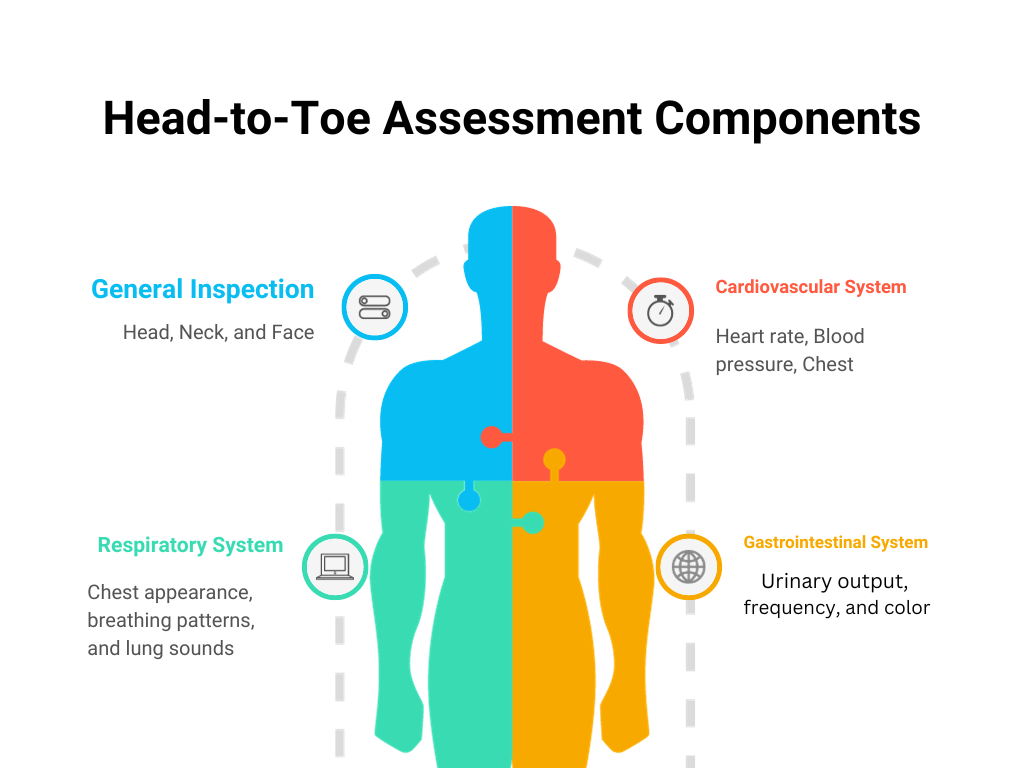Head-to-toe assessment is a physical examination of a patient to find out if there is any disorder or disease in the body from head to toe. This is the basic part of nursing practice, and healthcare professionals to collect information about the patient’s health status to identify problems and make a checklist or plan of care.
In this comprehensive guide we will cover the following aspects of the Head to toe assessment for nurses and healthcare professionals:
- Purpose of a Head-to-Toe Assessment
- When to Perform a Head-to-Toe Assessment
- Checklist of a Head-to-Toe Assessment
- Documentation of a Head-to-Toe Assessment
Purpose of a Head-to-Toe Assessment:
The main goal of performing a head-to-toe assessment is create a nursing care plan. So the major purposes are as follows:
- It helps to collect essential information about the patient’s health status.
- It helps to identify any potential health problems or abnormalities
- It helps monitor the patient’s response to treatment or interventions
When to Perform a Head-to-Toe Assessment:
Head to toe assessment is generally performed upon admission to a healthcare facility. It’s also performed at the beginning of each nursing shift. In some cases when patients condition changes or a daily physical checkup is performed then the assessment is also performed.

Checklist of a Head-to-Toe Assessment:
| Component | Example |
|---|---|
| General Inspection | 1. Overall appearance and behavior 2. Vital signs (temperature, pulse, respiration, blood pressure) 3. Level of consciousness and orientation |
| Head, Neck, and Face | 1. Scalp, hair, and facial features 2. Eyes, ears, nose, and throat 3. Lymph nodes |
| Respiratory System | 1. Chest appearance, breathing patterns, and lung sounds 2. Respiratory rate, effort, and oxygen saturation |
| Cardiovascular System | 1. Heart rate, rhythm, and sounds 2. Blood pressure and pulse characteristics 3. Chest pain or discomfort |
| Gastrointestinal System | 1. Abdominal appearance and bowel sounds 2. Appetite, nausea, vomiting, and stool habits 3. Pain, tenderness, or masses |
| Genitourinary System | 1. Urinary output, frequency, and color 2. Pain or discomfort in the urinary tract 3. Reproductive health concerns |
| Musculoskeletal System | 1. Muscle strength, tone, and mobility 2. Joint pain, swelling, or limitations 3. Gait and posture |
| Neurological System | 1. Level of consciousness, orientation, and memory 2. Cranial nerve function 3. Sensory function and motor strength |
| Skin and Integumentary System | 1. Skin color, texture, and moisture 2. Lesions, rashes, or wounds 3. Hair distribution and texture |
Documentation of a Head-to-Toe Assessment:
After a successful inspection of patients disease or disorder make a documentation of all findings in the patient medical record. Add the following aspects:
- Summary of the patient’s appearance and behavior
- Symptoms for each body system
- Problems or abnormalities identified
- Nursing implemented
Head to Toe Assessment NCLEX Questions:
Here are some head-to-toe assessment NCLEX questions:
Remember, when performing a head-to-toe assessment, behave with the patient like a healthcare professional. Maintaining the privacy of a patient should be the first priority. Use appropriate communication to get a positive response from the patient. Make the documentation accurate according to your findings with your best competency techniques.